Table of Contents
CBSE Sample Papers for Class 12 Economics Delhi – 2015
Time allowed : 3 hours Maximum marks 100
GENERAL INSTRUCTIONS
- All questions in both the sections are compulsory.
- Marks for questions are indicated against each.
- Questions No. 1-5 and 17-21 are very short-answer questions carrying 1 nick each. They are required to be answered in one sentence each.
- Questions No. 6-10 and 22-26 are? short-answer questions carrying 3 marks each. Answers to them should normally not exceed 60 words each.
- Questions No. 11-13 and 27-29 are also short-answer questions carrying 4 marks each. Answers to them should normally not exceed 70 words each.
- Questions No. 14-16 and 30-32 are long-answers questions carrying 6 marks each. Answers to them should normally not exceed 100 words each.
- Answers should be brief and to the point and the above word limit should be adhered to as far as possible.
SET I
SECTION A
Question.1. Give equation of Budget Line.
Answer.

Question.2. When income of the consumer falls the impact on price-demand curve of an inferior good is: (choose the correct alternative)
(a) Shifts to the right.
(b) Shifts to the left.
(c) There is upward movement along the curve.
(d) There is downward movement along the curve.
Answer. (a) Shifts to the right
Question.3. If Marginal Rate of Substitution is constant throughout, the Indifference curve will be: (choose the correct alternative)
(a) Parallel to the x-axis. (b) Downward sloping concave.
(c) Downward sloping convex. (d) Downward sloping straight line.
Answer. (d) Downward sloping straight line.
Question.4. Giving reason comment on the shape of Production Possibilities Curve based on the following schedule:
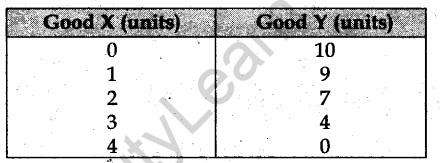
Answer. The shape of PPC would be downward sloping and concave to the origin because of increasing marginal rate of transformation.
Marginal Rate of Transformation (MRT) is the ratio of number of units of a commodity sacrificed to gain an additional unit of another commodity.

Increasing MRT means that more and more of commodity Y will have to be sacrificed for a unit increase in the production of commodity X. This happens because the resources are not equally efficient in production of all commodities.
Question.5. What will be the impact of recently launched ‘Clean Indian Mission’ (Swachh Bharat Mission) on the Production Possibilities curve of the economy and why?
Answer. The ‘Clean India Mission’ has been recently launched by the government. A cleanliness drive would ensure a cleaner, healthier and hygienic environment which reduces chances of people falling ill, which in turn will reduce forced absenteeism from work thereby increasing efficiency and productivity levels along with better utilization of available resources. Rise in this potential shifts PPC to the right signifying an increase in its productive capacity.
Or
What will likely be the impact of large scale outflow of foreign capital on Production Possibilities curve of the economy and why?
Answer. Large scale outflow of foreign capital would lead to reduction in the resources available to an economy. Decline in resources would further lead to a decline in the country’s overall capacity .to produce. This would then result in a downward shift in the production possibilities curve because the economy can now produce less of both commodities keeping in mind the reduction in available resources.
Question.6. The measure of price elasticity of demand of a normal good carries minus sign while price elasticity of supply carries plus sign. Explain why?
Answer. The minus sign of the measure of price elasticity of demand of a normal good is indicative of the inverse relationship between price of a commodity and its quantity demanded. If price increases the quantity demanded of a commodity decreases and vice versa which is , why the co-efficient of price elasticity of demand is negative.
On the other hand, measure of price elasticity of supply carries plus sign due to the direct relationship between price of a commodity and its supply. If price of the commodity increases its supply would also increase and vice versa. This means that since both change in supply and change in price will be in the same direction, therefore the resultant answer . would automatically carry a positive sign.
Question.7. There are large number of buyers in a perfectly competitive market. Explain the significance of this feature.
Answer. In a perfectly competitive market, there are very large number of buyers and sellers. This means that the number of buyers is so large that any individual buyer is not in a position to influence the market price on its own by purchasing more or less. It is because the individual buyer’s share in total purchase in the market is insignificant.
Question.8. Explain the effects of ‘maximum price ceiling’ on the market of a good. Use diagram.
Answer. Maximum price ceiling refers to fixing the maximum price of a commodity by the government at a level lower than the equilibrium price.
In the diagram, demand curve and supply curve intersect each other at point E where the equilibrium price is OP and OP1 is the price ceiling. The equilibrium price OP being too high, many people cannot afford the commodity at this price. Wheat being an essential commodity, government fixes the maximum price at OP1 at which the quantity demanded exceeds the quantity supplied By \({ Q }_{ S }{ Q }_{ D}\) This creates a shortage in the market equal to MN(\({ Q }_{ S }{ Q }_{ D}\) ) which may ultimately lead to hoarding and black marketing.
To prevent this situation and to ensure that the basic demand of wheat consumers is met, the government has enforced the system of rationing through the. public distribution system. Through the system of rationing, the government tries to sell a minimum quota of essential commodities such as wheat below the equilibrium price or at cheaper price to the poor community.
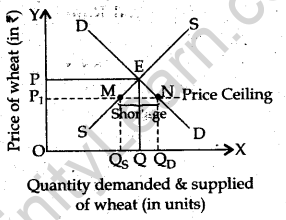
For the blind candidates only in lieu of Q. No. 8.
What is price ceiling? Explain the effects of maximum price ceiling.
Answer. Price ceiling means putting the upper limit by the government on the price that can be charged by the producers of a good from the buyers. Maximum price ceiling is lower than equilibrium price, pleading to a rise in demand and fall in supply. This creates shortage of the good in the market which may further lead to black marketing and hoarding.
Question.9. A consumer spends Rs 1000 on a good priced at Rs 8 per unit. When price by 25 per cent, the consumer continues to spend Rs 1000 on the good. Calculate price elasticity of demand by percentage method.
Answer.

Question.10. Define cost. State the relation between marginal cost and average variable cost.
Answer. Cost in economics refers to the shin of actual money expenditure on inputs and the imputed expenditure in the form of inputs supplied by the owners including normal profit.
Relation between MC and AVC:
(i) Both AVC and MC are derived from TVC and are U-shaped due to the law of variable proportions.
(ii) When MC is less than AVC , AVC falls.
(in) When MC is equal to AVC, AVC is constant and at its minimum point.
(iv) When MC is more than AVC, AVC rises with increase in output.
(v) Thereafter, both AVC and MC rise, but MC increases at a faster rate as compared to AVC ”
Or
Define revenue. State the relation between marginal revenue and average revenue.
Answer. Revenue in economics refers to the amount received by a firm from the sale of a given quantity of a commodity in the market or the market value of output produced.
Relationship between AR and MR:
(i) When price remains constant,
MR and AR curve is a horizontal straight line parallel to X axis as MR = AR = Price.
(ii) When price-falls with rise in output,
Both MR and AR fall with increase in output but MR falls at double rate than AR.
General Relationship between AR arid MR:
(i) AR increases as long as MR is higher than AR (MR>AR, AR increases)
(ii) When MR=AR, AR is maximum.
(iii) When MR<AR, AR falls.
Question.11. A consumer consumes only two goods X and Y both priced at Rs 3 per unit. If the consumer chooses a combination of these two goods with Marginal Rate of Substitution equal to 3, is the consumer in equilibrium? Give reasons. What will a rational consumer do in this situation? Explain.
Answer.
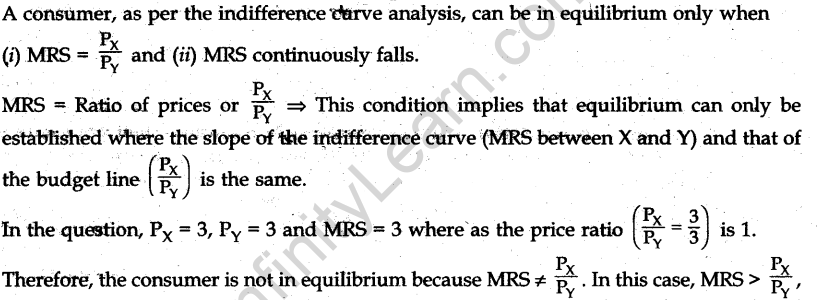
implying that the consumer is willing to sacrifice more units of Y as compared to what is required in the market. Therefore, a rational consumer will be induced to buy more units of X leading to a fall in MRS due to the Law of Diminishing Marginal Utility. This will continue till MRS becomes equal to the ratio of prices and equilibrium is established.
Or
A consumer consumes only two goods X and Y whose prices are Rs 4 and Rs 5 per unit respectively. If the consumer chooses a combination of the two goods with marginal utility of X equal to 5 and (hat of Y equal to 4, is the consumer in equilibrium? Give reasons. What will a rational consumer do in this situation? Use utility analysis.
Answer.
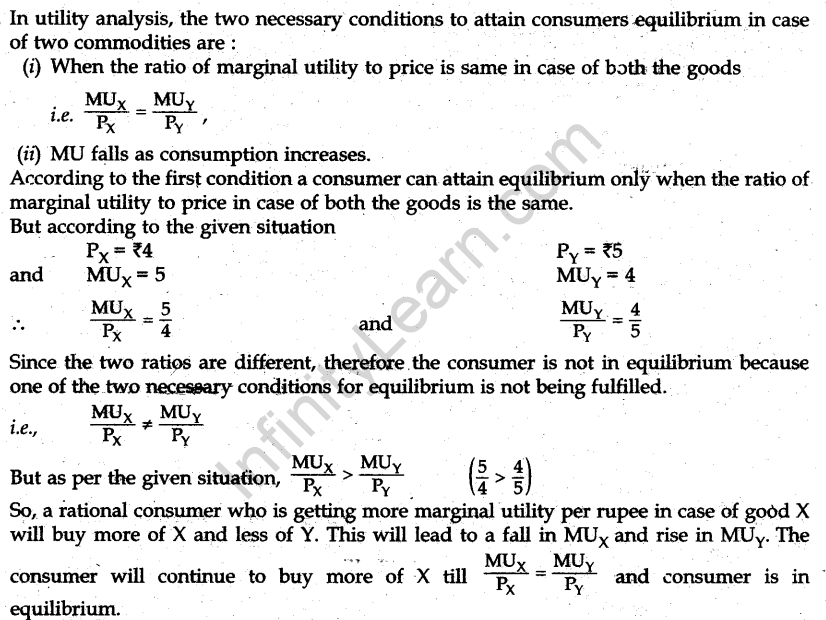
Question.12. State %e different phases of changes in Total Product and Marginal Product in the Law of Variable Proportions. Also show the same in a single diagram.
Answer. Law of variable proportions states that as we increase quantity of only one input keeping other inputs fixed, Total Product (TP) initially increases at an increasing rate (MP also increases and reaches its maximum point), then at a decreasing rate (MP falls but remains positive) and finally at a negative rate i.e., it falls (MP becomes negative).
This behavior of output can be shown through a diagram.
As shown in the diagram, the relation between input and output is discussed in three phases:
• Phase I: Increasing returns to a factor—TP increases at an increasing rate and MP also rises. This happens because as the variable factor increases, due to specialization its efficiency increases leading to better utilization of fixed factors.
• Phase II: TP increases at a decreasing rate and MP is declining but remains positive.This happens because with increase in the quantity
of variable input, a pressure is felt on the fixed factors. The amount of fixed input looks smaller than actually required to engage the increasing variable input reducing the efficiency of the & variable factor.
• Phase III: TP starts falling and MP becomes negative—This happens because the quantity of the variable input becomes too big in relation to the quantity of fixed inputs.
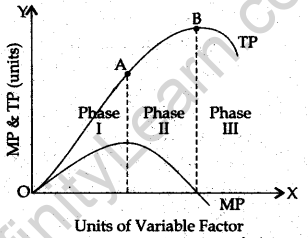
For the blind candidates in lieu of Q. No. 12 only.
State, on the basis of a numerical example, different phases of changes in Total Product and Marginal Product in the Law of Variable Proportions.
Answer. Law of Variable Proportions, also known as law of returns to a factor shows the nature of rate of change in output due to a change in variable factors. It shows how total product (TP) initially increases at an increasing rate, then at a decreasing rate and finally at a negative/rate due to change in only one variable factor of production.
This behaviour of output is shown through the following schedule.
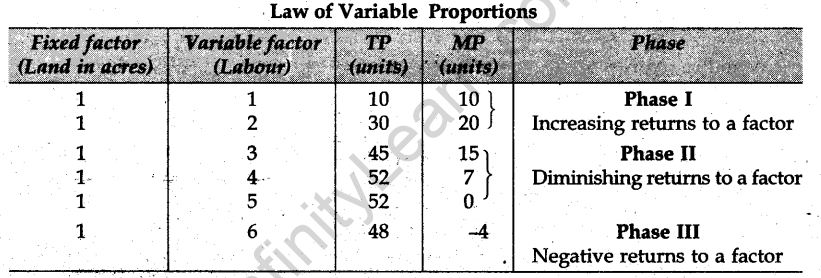
Phase I: Increasing returns to a factor. As shown in the schedule, on unit of labour produces 10 units whereas 2 units of labour produce 30 units implying that initially TP increases at an increasing rate and MP rises till it reaches its maximum point.
Phase II: Diminishing returns to a factor. After the 2nd labour, every additional unit of labour that is . increased increases TP but the rate of increases is decreasing leading to decline in MP. This phase ends with,TP becoming maximum and MP becoming zero.
Phase III: Negative returns to a factor. After the 5th unit, when the 6th unit of labour is employed, then TP starts falling as MP becomes negative due to conflict between fixed and variable factors and decline in efficiency of the variable factor. This phase ends with TP becoming maximum and MP becoming zero.
Question.13. Why is the equality between marginal cost and marginal revenue necessary for a firm to be in equilibrium? Is it sufficient To ensure equilibrium? Explain.
Answer. Producers equilibrium refers to that price and output combination which brings maximum profit to the producer and profit declines as more is produced.
In order to reach equilibrium the first condition which has to be satisfied is that MC has to be equal to MR (MC = MR).
To maximise profits, a firm compares its MR with its MC. Profits will increase as long as MR exceeds MC and profits will fall if- MR is less than MC. So, equilibrium is not achieved when MC < MR as it is still possible to add to profits by producing more. A producer is also not in equilibrium when MC > MR because then benefit is less than cost. This means that the firm will only be in equilibrium when MC = MR.
However MC = MR, though a necessary condition, is not sufficient enough to ensure equilibrium. It is because MC =MR may occur at more than one level of output.
However, out of these, only that output level is the equilibrium output when MC becomes greater than MR after the equilibrium. It is because if MC is greater than MR, then producing beyond MC = MR output level will reduce profits.
So, the first condition must be supplemented with the second condition to attain producer’s equilibrium.
.•.The two necessary conditions, under. MR-MC approach to attain producer’s equilibrium are:
(i) MC = MR
(ii) MC is greater than MR after MR = MC output level.
Question.14. Market for a good is in equilibrium. The demand for the good ‘increases’. Explain the chain of effects of this change.
Answer. Market demand curve DD and market supply curve SS intersect each other at point E, which is the market equilibrium where OQ is the equilibrium quantity. and OP is the equilibrium price.
An increase in demand (assuming no change in supply and price) leads to a rightward shift in demand curve from DD to D1D1 as shown in the diagram.
When demand increases to D1D1, it creates excess demand at the old equilibrium price of OP. This leads to competition amongst buyers which pushes up the price. As price increases demand decreases (Law of demand) and supply increases (Law of supply) as indicated by the arrows. These changes continue till new equilibrium is established at point E1 where the new equilibrium price rises from OP to OP1 and equilibrium quantity rises from OQ to OQ1.
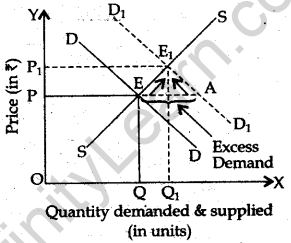
SECTION B
Question.15. What is ‘aggregate supply’ in macroeconomics?
Answer. Aggregate Supply refers to the money value of total quantity of final goods and services that all the producers are willing to supply in an economy in a given time period.
Question.16. The value of multiplier is: (choose the correct alternative)
(a) 1/MPC (b) 1/MPS (c) 1/1-MPS (d) 1/MPC-l
Answer. (b) 1/MPS
Question.17. Borrowing in government budget is: (choose the correct alternative)
(a) Revenue deficit (b) Fiscal deficit
(c) Primary deficit (d) Deficit in taxes
Answer. (b) Fiscal deficit
Question.18. The non-tax revenue in the following is: (choose the correct alternative)
(a) Export duty (b) Import duty (c) Dividends (d) Excise
Answer. (c) Dividends
Question.19. Other things remaining unchanged, when in a country the price ‘of foreign currency rises, national income is: (choose the correct alternative)
(a) Likely to rise (b) Likely to fall
(c) Likely to rise and fall both (d) Not affected
Answer. (a) Likely to rise
Question.20. If Real GDP is Rs 200 and Price Index (with base = 100) is 110, calculate Nominal GDP.
Answer.

Question.21. Name the broad categories of transaction? recorded in the ‘capital account’ of the Balance of Payments Accounts.
Answer. Capital account of Balance of Payments Account records all those transactions between the residents of a country and the rest of the world, which cause a change in the assets or liabilities of the residents of the country or its government.
Capital account is concerned with financial transfers. So it does not have any direct effect on income, output and employment of the country.
The categories of transactions recorded in the capital account are:
(i) Borrowings and lending to and from abroad. By private individuals, institutions, government, etc.
(ii) Investments to and from abroad. It includes investments from abroad (credits) in shares of Indian companies, real estate, etc. It also includes investment by Indian residents in shares of foreign companies, real estate abroad, etc.
(iii) Changes (Increase and Decrease) in foreign exchange reserves. Treated as a financial asset of the government, a withdrawal from this reserve leads to a decrease in foreign financial asset (recorded on credit side) and vice versa.
Or
Name the broad categories of transactions recorded in the ‘current account’ of the – Balance of Payments Accounts.
Answer. Categories of transactions recorded in the current account of the Balance of Payments Accounts are as follows:
(i) Export and Import of goods (visible). Balance of these visible exports and imports is known as balance of trade.
(ii) Export and Import of services (invisible trade), like shipping, banking, insurance, etc.
(iii) Unilateral transfers. It includes gifts, donations, personal remittances etc.
(iv) Income receipts and payments to and from abroad. It includes investment income in the form of interest, rent and profits.
Question.22. Where will sale of machinery to abroad be recorded in the Balance of Payments Accounts? Give reason.
Answer. Sale of machinery abroad will be considered as export of visible item of trade and will be a part of country visible trade. Visible trade, i.e., export and import of goods is recorded in Current account of Balance of Payments Accounts (BOP).
Since receipt from exports is .shown on the positive side (credit item), therefore Sale, of machinery abroad brings in foreign exchange and will be shown as credit item in the current account of BOP.
Question.23. Explain the ‘bank of issue’ function of the central bank.
Answer. Central Bank has the sole authority for issue of currency in the country. In India, RBI has the sole right of issuing paper currency notes (except one rupee notes and coins, which are issued by the Ministry of Finance). The reason for this is that it brings about uniformity in note circulation and gives the Central Bank direct control over the money supply. It promotes efficiency in the financial system.
Or
Explain’Government’s Bank function of central bank.
Answer. A central bank conducts the banking accounts of government departments. It performs the same banking functions for the government as a commercial bank performs for its customers. It accepts their deposits and undertakes inter-bank transfers. It also gives loads to the government. As an agent, it manages the government’s public debt. It undertakes payment of interest on this debt and other related services to public debt. It accepts the payment of taxes from the public on behalf of the government and makes payment for the cheques issued by the government.
It also gives advise to the government regarding money market, capital market, government loans and on economic policy- matters.
Question.24. Government of India has recently launched ‘Jan Dhan Yojna’ aimed at every household in the country to have at least one bank account. Explain how deposits made under the plan are going to affect national income of the country.
Answer. The ‘Jan Dhan Yojna’ recently launched by the government aims at having at least one bank account per household. Bank accounts or demand deposits are a part of the money supply of the country.
— Opening more bank accounts means more bank deposits. More the demand deposits more would be the money supply.
— Also increase in the amount of the demand deposits, legal reserve ratio remaining the same, increases a bank’s capacity for money creation or credit creation as new deposits in banks lead to creation of more deposits by banks.
— Increase in the deposits with commercial banks would mean an increase in their lending capacity.
— More lending by banks means more investment and capital formation in the economy. — As a result, aggregate demand rises leading to an increase in the national income of the country.
Question.25. An economy is in equilibrium. Calculate national income from the following:
Autonomous consumption = 100
Marginal propensity to save = 0.2
Investment expenditure = 200
Answer.
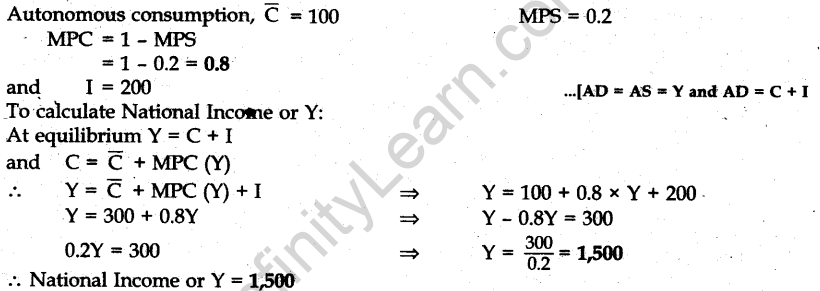
Question.26. Giving reason explain how should the following be treated in estimation of national income:
(i) Expenditure by a firm on payment of fees to a chartered accountant (ii) Payment of corporate tax by a firm.
(iii) Purchase of refrigerator by a firm for own use
Answer. (i) It will not be included as expenditure by a firm on payment of fees to a chartered accountant is intermediate expenditure and hence will not be considered while calculating national income.
(ii) Payment of corporate tax by a firm is a transfer payment and thus not included in estimation of national income. However, corporate tax is included while estimating national income because it is a part of profit of a joint stock company which is a factor income.
(iii) It will be included in national income because money spent by firm on purchase of refrigerator for own use will be considered as investment expenditure and is thus included.
Question.27. Explain the concept of Inflationary Gap. Explain the role of Repo Rate in reducing this gap.
Answer. Concept of inflationary gap. If equilibrium level of income is determined after the stage of full employment, it is a situation of excess demand. Excess demand refers to the situation when aggregate demand (AD) is more than the aggregate supply (AS) corresponding to full employment level of output in the economy. Excess demand gives rise to inflationary gap.
Inflationary gap refers to the gap by which actual aggregate demand exceeds the aggregate demand required to establish full employment equilibrium. As a result of excess demand, prices increase because corresponding to increase in demand, output cannot increase.
Repo rate is the rate of interest charged by Central Bank on loans given to commercial banks. During actuation of excess demand leading to inflation, the Central Bank raises the repo rate which discourages commercial banks in borrowing from the Central Bank. Increase in repo rate forces commercial banks to increase their own lending rates making – credit costlier. As a result, the demand for loans falls discouraging investment. Also reduction in availability of credit helps in correcting the situation of excess demand and reducing inflationary gap.
Or
Explain the concept of Deflationary Gap and the role of ‘Open Market Operations’ in reducing this gap.
Answer. Concept of deflationary gap. If equilibrium level of income is determined before the stage of full employment, it is a situation of deficient demand. This situation arises when planned aggregate expenditure falls short of aggregate supply at the full employment level. It gives rise to deflationary gap.
In such a situation due to inadequacy of demand, production will be less and therefore involuntary unemployment will be created. This means that all the resources will not be fully employed. Therefore the deficiency in aggregate demand at full employment level is the measure of deficient demand. It also means that during deficient demand, equilibrium is determined at a level less than full employment equilibrium.
Role of Open Market Operations. Open market operations refer to sale and purchase of government securities in the open market by the Central Bank. During deficient demand, the central bank starts purchasing securities from the open market. Those who sell receive payments by cheques from the Central Bank. The money flows out from Central Bank into the commercial banks. This raises lending capacity of commercial banks. As banks lend more, spending rises which increases the money supply in the economy which further increases the level of aggregate demand in the economy thereby correcting the situation of deficient demand and reducing deflationary gap.
Question.28. Explain the role the government can play through the budget in influencing allocation of resources.
Answer. An important objective of government budget is to allocate resources for accomplishing socio-economic objectives of the government. There are a number of projects and activities for which resources are allocated. Through budgetary policy, government aims to influence allocation of resources in the following ways:
(i) Tax concessions or subsidies. To encourage investment, government can give tax concessions, subsidies etc. to the producers. The government discourages the production of harmful consumption goods (like liquor, cigarettes, etc.) through heavy taxes and encourages the production of ‘khadi products’ and other products useful for the masses by providing subsidies and recessions.
(ii) Directly producing goods and services. If private sector does not take interest due to lack of profits, government can directly undertake the production of certain goods and services.
(iii) Resources may be allocated for increasing investment, reducing income inequalities (by imposing taxes on the rich) and providing better healthcare and education facilities.
Question.29. Calculate National Income and Personal Disposable Income:
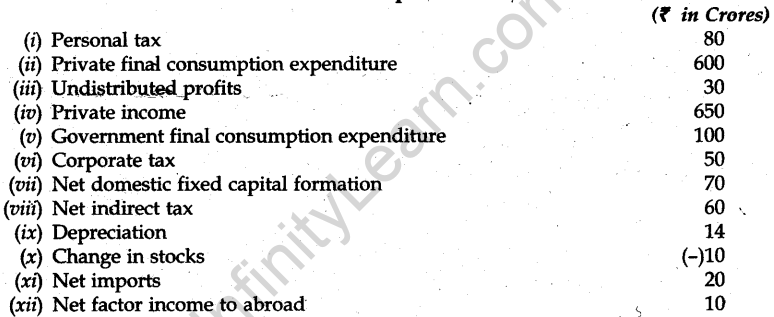
Answer.

SET II
Note: Except for the following questions, all the remaining questions have been asked in Set-I.
SECTION A
Question.2. Give equation of Budget Set.
Answer.

Question.5. Giving reason comment on the shape of Production Possibilities Curve based on the following schedule:
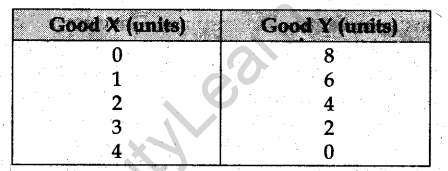
Answer.

Since the marginal rate of transformation, i.e., MRT is constant,
PPC will be a downward sloping straight line. This means that the same amount of a commodity (Good Y) is sacrificed to gain an additional unit of another commodity (Good X)- It is possible only when we assume that all the resources are equally efficient in . production of all goods.
Question.10. A consumer spends Rs 60 on a good priced at Rs 5 per unit. When price falls by 20 per cent, the consumer continues to spend Rs 60 on the good. Calculate price elasticity of demand by percentage method.
Answer.

Question.11. Market for a good is in equilibrium. The demand for the good ‘decreases’. Explain the chain of effects of this change.
Answer. See Q. 14, 2014 (II Delhi).
SECTION B
Question.21. If the Nominal GDP is 71200 and Price Index (with base = 100) is 120, calculate Real GDP.
Answer.

Question.23. An economy is in equilibrium. Find ‘autonomous consumption’ from the following:
National Income = 1000
Marginal propensity to consume = 0.8
Investment expenditure = 100
Answer. Y = 1000 MPC = 0.8 I=100

Question.29. Calculate ‘Gross National Product at Market Price’ and ‘Net National Disposable Income’:

Answer.

SET III
Note: Except for the following questions, all the remaining questions have been asked in Set-I and Set-II.
SECTION A
Question.3. Define Budget Set.
Answer. Budget set refers to the set of possible combinations of only two goods the consumer consumes which he can afford from his income and given prices.
Question.5. Explain the feature ‘interdependence of firms’ in an oligopoly market.
Answer. Firms under oligopoly are interdependent. Interdependence means that actions of one firm affect the actions of other firms. A firm considers the action and reaction of the rival firms while determining its price and output levels. A change in output or price by one firm evokes reactions from other firms operating in the market.
Question.8. Giving reason comment on the shape of Production Possibilities Curve based on the following schedule:
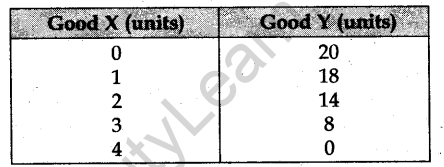
Answer.

Since the above schedule is representing increasing MRT, i.e., more and more of Y have to be sacrificed for a unit increase in production of X, therefore, the PPC in the case will be a downward sloping curve which is concave to the origin.
Question.9. A consumer spends ?100 on a good priced at Rs 4 per unit. When price falls by 50 per cent, the consumer continues to spend Rs 100 on the good. Calculate price elasticity of demand by percentage method.
Answer.

Question.12. Market for a good is in equilibrium. Supply of the good ‘increases’. Explain the chain of effects of this change.
Answer. Market equilibrium is determined when the quantity demanded of a commodity becomes equal to the quantity supplied. The price determined corresponding to market equilibrium is known as equilibrium price and the corresponding quantity is known as equilibrium quantity.
As shown in the diagram, original equilibrium is determined at point E where die original demand and supply curves intersect each other where OQ is the equilibrium quantity and OP is the equilibrium price.With increase in supply, demand remaining unchanged the supply curve shifts from SS to S1S1. When supply increases to S1S1, it creates a situation of excess supply at the old equilibrium price of OP. This leads to competition among sellers, which reduces the price. Decrease in price leads to rise in demand and fall in supply. These changes continue till the new equilibrium is established at point E1.
Equilibrium price falls from OP to OP1 and equilibrium quantity rises from OQ to OQ1.
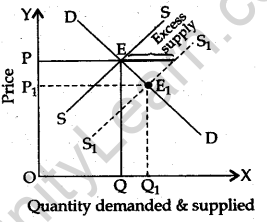
SECTION B
Question.22. If the Real GDP is Rs 300 and Nominal GDP is Rs 330, calculate Price Index (base = 100).
Answer.

Question.24. An economy is in equilibrium. Find Marginal Propensity to Consume from the following:
National income = 2,000
Autonomous consumption = 400
Investment expenditure = 200
Answer.

Question.29. Calculate ‘Net Domestic Product at Factor Cost’ and ‘Gross National Disposable Income’:
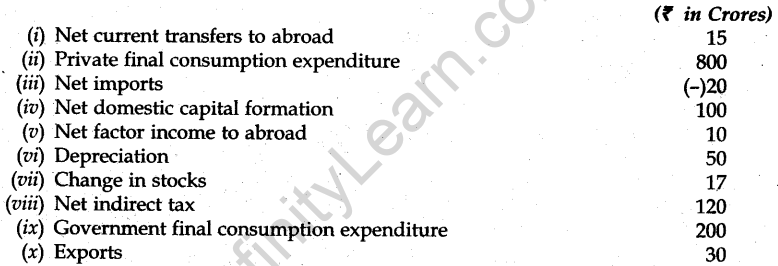
Answer.




